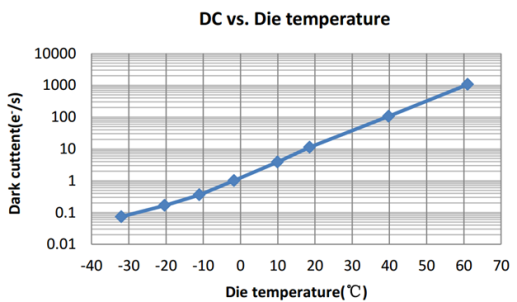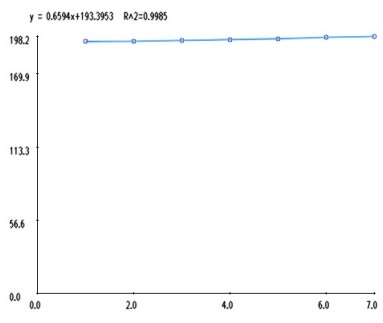About Dark current
Definition of Dark current
The thermionic emission (also known as: thermal excitation) of electrons by image sensor, even in the absence of a light input is regarded as Dark current. The unit of Dark current is e-/s/pixel. The thermal noise is the result of dark current multiplied by the period of exposure (exposure time). The magnitude of dark current is associated with the temperature of image sensor, the higher temperature of the senor, the higher dark current achieved.
The following Figure shows the specific phenomenon that the dark current ascends significantly with the rise of temperature.

Method of Calculation
Collect multiple sets of individual dark field value under different exposure times (the average of multiple frames) and same temperature, fit a curve, the quotient, which comes from slope divided by the K value of system gain, is the value of the dark current.

How dark current affect the quality of images
There are three mainstay factors which affect the quality of images directly: (1) The background resulting from dark current; (2) Hot pixel, which is a pixel that reads bright on longer exposures due to charge leakage; (3) Shot noise, caused by statistical quantum fluctuations, is also known as photon shot noise.
These three factors come from the root which is the electrons accumulation of dark current in the pixels associating with the exposure time. Shorter exposure time, or cooling the camera are able to alleviate or solve the problems fundamentally.
Measures to reduce dark current
Dark current is primarily caused by the thermal generation of charge carriers within the semiconductor material—mainly in the depletion region of each pixel—so its magnitude depends strongly on temperature. However, manufacturing process imperfections such as crystal defects, impurities, or interface traps can introduce localized generation centers that lead to increased pixel-to-pixel variation (fixed-pattern noise) and the occurrence of hot pixels.
When the working temperature rises, electrons move more vigorously and abnormal migration occurs, increasing the likelihood of noise and resulting in a stronger dark current as a visible effect.
If a camera operates for a certain period under a non-cooled condition, its dark current level will rise and the signal-to-noise ratio (SNR) will drop due to the thermal effects of power consumption. Therefore, certain measures should be taken to help dissipate the heat of the sensor. Two common cooling approaches are air cooling and liquid cooling.
1. Air cooling system is composed of a heat-sink and a fan posterior to it. The metal heat-sink attaches to the heat origin closely and conducts the heat out with larger radiating surface between the heat origin and air. With the synchronous working of fan, inducing the outer air inside, heat is absorbed by air and the heated air is exhausted through the port.
2. The realization of liquid cooling is via the working of exterior liquid-recycling system. Cooling tunnels are designed between the heat origin interior to camera and the heat-sinks. The recycled liquid (water or coolant) runs around the cooling tunnels, abstracts and transports away the heat generated by camera.
Another crucial factor to the image quality via the way of dark current is the exposure time. Since dark current might accumulate in the pixels, associating with time, then the longer a time the exposure is, the more accumulated electrons might be inside the pixels. Thence, cooling has huge significance when a camera is required to work for long time exposure, because of the extreme weak illumination.
Conventional deep-cooled camera will utilize multi-stage Peltier cooling system, or even liquid nitrogen cooling system to accomplish the -20℃or lower of working circumstance for the camera. Long time exposure becomes applicable and satisfactory when the dark current level of the sensor is reduced with such a huge amplitude.
How effective is cooling in improving camera performance?
The following figure compares the performance of the Dhyana 400BSI camera in the state of cooling and non-cooling:
Both under the circumstance of dark field imaging with a 10s exposure time, the one from cooling camera has advantages over the one from a non-cooling one, as to the Mean and standard deviation value, the image quality.



 2022/02/07
2022/02/07







